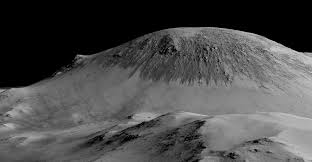Using an imaging spectrometer on MRO, researchers detected signatures of hydrated minerals on slopes where mysterious streaks are seen on the Red Planet. These darkish streaks appear to ebb and flow over time. They darken and appear to flow down steep slopes during warm seasons, and then fade in cooler seasons. They appear in several locations on Mars when temperatures are above minus 10 degrees Fahrenheit (minus 23 Celsius), and disappear at colder times.
“Our quest on Mars has been to ‘follow the water,’ in our search for life in the universe, and now we have convincing science that validates what we’ve long suspected,” said John Grunsfeld, astronaut and associate administrator of NASA’s Science Mission Directorate in Washington. “This is a significant development, as it appears to confirm that water -- albeit briny -- is flowing today on the surface of Mars.”
These downhill flows, known as recurring slope lineae (RSL), often have been described as possibly related to liquid water. The new findings of hydrated salts on the slopes point to what that relationship may be to these dark features. The hydrated salts would lower the freezing point of a liquid brine, just as salt on roads here on Earth causes ice and snow to melt more rapidly. Scientists say it’s likely a shallow subsurface flow, with enough water wicking to the surface to explain the darkening.
These dark, narrow, 100 meter-long streaks called recurring slope lineae flowing downhill on Mars are inferred to have been formed by contemporary flowing water. Recently, planetary scientists detected hydrated salts on these slopes at Hale crater, corroborating their original hypothesis that the streaks are indeed formed by liquid water. The blue color seen upslope of the dark streaks are thought not to be related to their formation, but instead are from the presence of the mineral pyroxene.
"Our results may point to more habitable conditions on Mars that previously thought," said Mary Beth Wilhelm, one of the paper's co-authors, at the NASA press conference. She added that scientists will need to learn more about the briny water.
"It is very likely, I think, that there is microbial life somewhere in the crust of Mars," said Alfred McEwen of the University of Arizona, who also worked on the study.
Wilhelm noted that in addition to supporting Martian life, water may be an important resource for human exploration and activity on the planet, by making it easier and less expensive to travel to the Red Planet.
Grunsfeld said Mars has other resources that may make it possible to grow plants, including nitrogen and carbon dioxide. Would-be farmers could build greenhouses on the planet that could grow plants—even food for inhabitants.
He said that today's announcement gives more reason to send astrobiologists and other scientists to answer the question of whether there is life on the planet.
"We can answer that question by sending rovers and by sending people," Grunsfeld said.
Full story at:https://www.nasa.gov/press-release/nasa-confirms-evidence-that-liquid-water-flows-on-today-s-mars



